|
|
|
CONTACT US
Click Here! |
| This site is best viewed with a screen resolution of 800 X 600 at high colour settings |
|
Flask list
Acacallis-Ancistrochilus Angraecum-Aspasia Barkeria-Broughtonia Bulbophyllum Capanemia-Catasetum Cattleya Cattleyopsis-Cycnoch, Cymbidium-Cyrtorchis Dendrobium-Dossinia Encyclia-Eulophiella Galeandra-Kalopternix Laelia-Lycaste Macodes-Nephalaphyll, Odontogloss,-Oncidium Paphiopedilum-Psychilis Rangaeris-Stenocoryne Tainia-Zygopetalum |
|
Plant list
Acampe-Bulbophyllum Cattleya-Dossinia Encyclia-Promeaea Renanthera-Vanda |

BP SPECIES NEWSLETTER November 2001Jan01 Feb Mar April May June July August September October

Photos in this issue: Above Habenaria species Mexico. Paraphalaenopsis laycockii, Nervilia discolor, Laelia millerii, Sophronitis brevipedunculata.Do you know any orchid growers who may like to receive this newsletter? Why not forward this email to them now!A b&w printed copy of this Newsletter can be mailed each month if you send 12 Australian stamps or 12 International reply coupons to Burleigh Park Orchid Nursery, 54 Hammond Way, Thuringowa, Australia 4815.Items in this newsletter may be reproduced provided source acknowledged.We commend "Orchids Online Web Design" for the excellent work on our web site and this Newsletter.For information or prices click here or email Steve at steve@orchidsonline.com........A. What's New in flask.Habenaria species Mexico. This is so far unidentified, any suggestions would be welcome (photo above). A subterranean tuber, with a tall leafy stem, this requires a rich soil leafmould media in a well drained pot. Deciduous in winter, a repot each spring is of benefit. Maximum sunlight, short of leaf burn, and a warm spot in the orchid house.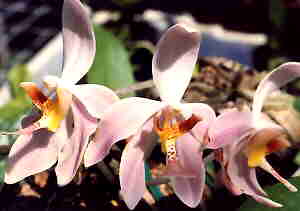 Paraphalaenopsis laycockii.
Paraphalaenopsis laycockii.
A robust growing species that needs a shallow pot/basket or a piece of treefern. A media that will hold some moisture or well watered treefern and maximum sunlight is needed. The flowers are a soft pink, quite large, being the largest flowered species of the genus. A warm grower, must be well drained as it is intolerant of wet conditions. Trichoglottis ionosma "Formosa". This is an upright growing species that needs a shallow pot or basket. As it does not climb, it is easily managed and will develop into a clump with many branched spikes of yellow marked pale to dark brown flowers, fragrant. A warm to intermediate grower, lots of sulight. B. What's ready to replate NOW.Cochleanthes lehmanii. This is a soft foliage large fan like plant.The flowers are large and spectacular. Best grown in a small pot with spaghnam moss, it requires good shade and a cool to intermediate climate in the orchid house. In warmer climates, some extra shade can protect the plant during the hotter part of the year.Phragmipedium lindenii "Bergold". This is seed from the collection of Gernot Bergold, Venezuela. Tall spike of large green flowers with redbrown veins. A pot with a spaghnam moss type media that will retain moisture is required,as these plants do not like to dry out. When plants are well established, extra sunlight can be of benefit. Catasetum macrocarpum. This is a Brazilian species with a helmet like labellum, the flowers are green yellow spotted red, the large lip fleshy, yellow. A fragrant species, warm to intermediate but also adaptable to cooler areas because the plants are dormant during winter and can be removed from the orchid house. In Spring and with warmer weather, plants should be repotted and placed back into the growing area. Cattleya gaskelliana alba x self. This is a large flowered labiate cattleya with flowers to six inches across (15cm). Best grown in a shallow pot in an open media that allows good drainage. Intermediate grower from Brazil. C. What's new in Plants.Jumellia comorense. A small warm to intermediate growing species that does well in a small basket, well crocked, in a mixture of shredded spaghnam moss and isolite. The very elegant pure white fragrant flowers have a long curved spur. A little extra shade is of benefit, with maximum air movement as these Angraecoids do not like stale conditions. Currently plants are flowering in 80 mm basket pots.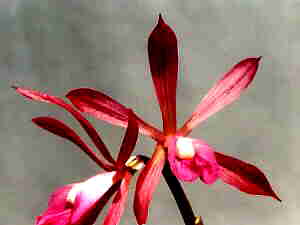 Catasetum expansum and Catasetum laminatum. Established advanced seedlings are growing robustly in 50/50 spagh/isolite mix in 80mm slotted pots and basket pots. Deciduous in winter, the plants should be removed from the orchid house and allowed to dry out. In spring, when new shoots appear, a repot into a rich media will ensure large pseudobulbs and flowers. A liberal dose of manure promotes a robust plant.
Catasetum expansum and Catasetum laminatum. Established advanced seedlings are growing robustly in 50/50 spagh/isolite mix in 80mm slotted pots and basket pots. Deciduous in winter, the plants should be removed from the orchid house and allowed to dry out. In spring, when new shoots appear, a repot into a rich media will ensure large pseudobulbs and flowers. A liberal dose of manure promotes a robust plant.
C. expansum has huge ivory to cream flowers, C. laminatum has cream yellow flowers spotted and marked red, with a most unusual labellum 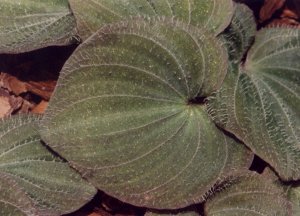 Bulbophyllum othonis. A Philippino species that produces masses of cream upside down daisy like flower umbels. Very prolific flowerer, the plants do best in a shallow tray or a large treefern slab with extra water. Currently growing in both bark and spaghnam mixs, each with shredded isolite. A little extra shade until the plants establish, then lots of sunlight will produce a plant with green purple leaves and bulbs and lots of cream flowers. A warm to intermediate grower.
Bulbophyllum othonis. A Philippino species that produces masses of cream upside down daisy like flower umbels. Very prolific flowerer, the plants do best in a shallow tray or a large treefern slab with extra water. Currently growing in both bark and spaghnam mixs, each with shredded isolite. A little extra shade until the plants establish, then lots of sunlight will produce a plant with green purple leaves and bulbs and lots of cream flowers. A warm to intermediate grower.
Nervilia discolor (above right- flower and leaf). Now is the time to ship this terrestrial, while the tubers are starting to shoot up with warmth and water. A small tuber puts up an attractive heart shaped leaf, green, flushed purple, best grown in a small pot in a leafmould rich soil media. While growing maximise water and grow in a good shady spot as it is a dweller of the edges of rainforest in heavy shade. D. Culture
Got a southern or northern window that could do with a new view??
|
|
Suppliers of Fine Orchid Literature
|
Grahame & Margaret Muller
Fax: 07 4122 4539 International Fax: + 61 7 4122 4539
P O Box 4192 Tinana, Qld, AUSTRALIA 4650.
Email:gmuller@mary.big.net.au
ORCHIDACEOUS BOOKS is an Australian specialist supplier of orchid literature.
We stock more than 100 new titles with more available at short notice.
We buy and sell pre-owned titles and generally stock in excess of 150 pre-owned titles.
If you are searching for a particular title - New or Pre-owned - email us now for our current catalogue as we may have it in stock or may be able to source it for you.
All stock available for world wide delivery
H. A special note on flasking orchids.
Due to the need for a filtered air vent on flasks to allow exchange of gasses, a reliable air filter medium is needed.Non absorbant cotton wool allows gas exchange but does not absorb moisture. Thus the air filter will stay dry and prevent the growth of fungus thru the filter, a common problem with ordinary cotton wool which gets wet, goes mouldy and allows the mould to grow thru the filter to contaminate the flask.
Non Absorbant Cottonwool NOW AVAILABLE in 375 gram rolls, contact us NOW.
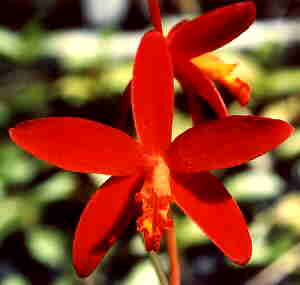 The secret to growing orchids is to provide light and humidity and grow plants in a media that will stay damp but not wet. Extra light can be provided with the natural daylight fluorescent tubes that are readily available.
The secret to growing orchids is to provide light and humidity and grow plants in a media that will stay damp but not wet. Extra light can be provided with the natural daylight fluorescent tubes that are readily available.
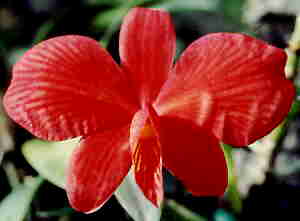 A media that works well for these is spaghnam moss mixed with shredded isolite, a pot well crocked, and with the pot
sitting on the wet sand/pebbles, adequate humidity is supplied. Deciduous orchids such as Habenaria and Calanthe ( terrestrial, soil and leafmould media), Catasetums, Mormodes, Cycnoches ( spaghnam) also are well suited.
A media that works well for these is spaghnam moss mixed with shredded isolite, a pot well crocked, and with the pot
sitting on the wet sand/pebbles, adequate humidity is supplied. Deciduous orchids such as Habenaria and Calanthe ( terrestrial, soil and leafmould media), Catasetums, Mormodes, Cycnoches ( spaghnam) also are well suited.
 Flasks can be imported into most countries without the requirement for a Phytosanitary
Certificate.
Flasks can be imported into most countries without the requirement for a Phytosanitary
Certificate.